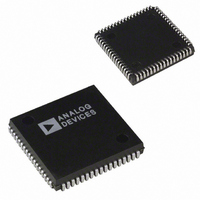ADMC200AP Analog Devices Inc, ADMC200AP Datasheet - Page 8

ADMC200AP
Manufacturer Part Number
ADMC200AP
Description
IC MOTION CO-PROC 12.5MHZ 68PLCC
Manufacturer
Analog Devices Inc
Datasheet
1.ADMC200AP.pdf
(12 pages)
Specifications of ADMC200AP
Rohs Status
RoHS non-compliant
Applications
*
Mounting Type
Surface Mount
Package / Case
68-PLCC
ADMC200
Operating/Using the Vector Transformation Block
After powering up the ADMC200, RESET must be driven
low for a minimum of two clock cycles to enable vector
transformations.
The vector transformation block can perform either a forward or
reverse transformation.
Reverse Transformation is defined by the following operations:
(a) Clarke: 3-phase current signals to 2-phase current signals
followed by (b) Park: 2-phase current signals cross multiplied by
sin , cos
with respect to the rotor (stationary) where is the electrical
angle of the rotor field with respect to the stator windings.
Forward transformation is defined by the following operations:
(a) Park: 2-phase voltage signals cross multiplied by sin , cos
followed by (b) Clarke: 2-phase to 3-phase voltage signal
conversion.
In order to provide maximum flexibility in the target system, the
ADMC200 operates in an asynchronous manner. This means
that the functional blocks (analog input, reverse transformation,
forward transformation and PWM timers) operate indepen-
dently of each other. The reverse and forward vector transfor-
mation operations cannot occur simultaneously. All vector
transformation registers, except for RHO/RHOP, are twos
complement. RHO/RHOP are unsigned ratios of 360 . For ex-
ample, 45 would be 45/360 2
Performing a Reverse Transformation
A reverse transformation is initiated by writing to the reverse
rotation angle register RHO and operates on the values in the
PHIP1, PHIP2 and PHIP3 registers. When the reverse trans-
formation is in 2/3 mode, PHIP1 is calculated from PHIP2 and
PHIP3. This is used in systems where only two phase currents
are measured. The reverse transformation 2/3 mode is set by
clearing Bit 10 in the SYSCTRL register and is the default
mode after RESET.
Reference Frame
V
Figure 10. Forward Clarke Transformation
y
V
q
Figure 9. Forward Park Transformation
Two-Phase Voltage
which effectively measures the current components
Stationary
Equivalent
V
V
x
d
12
.
120
Reference Frame
Three-Phase Stator
W
V
Rotating
Voltage
120
120
90
V
V
x
y
U
–8–
In order to perform a reverse transformation, first write to the
PHIP2 and PHIP3 registers, and to the PHIP1 register if not in
2/3 mode. Then initiate the transformation by writing the re-
verse rotation angle to the RHO register.
The reverse rotation will be completed in 37 system clock cycles
after the rotation is initiated. If Bit 6 of the system control reg-
ister is set, then an interrupt will be generated on completion.
When an interrupt occurs, the user must check Bit 1 of the
SYSSTAT register to determine if the vector transformation
block was the source of the interrupt.
During the vector transformation, the vector transformation
registers must not be written to or the vector rotation results
will be invalid.
Reverse Clarke Transformation
The first operation is the Clarke transformation in which the
three phase motor current signals (I
sine and cosine orthogonal signals (I
represent the equivalent currents in a two-phase ac machine and
is the signal format required for the Park rotation. The three-
phase input signals are of the form:
PHIP1 I
PHIP2 I
PHIP3 I
and the Park rotation requires inputs in the form I
I
This is calculated from:
IY
After the reverse transform, registers I
phase input current information.
In the case where 2 of 3-phase information (PHIP2/3 only) is
provided, then PHIP1 will be derived from the simple fact that
all sum to zero. This value is then placed in the IX register.
IX = I
Reverse Park Rotation
IX/IY are then processed together with the digital angle
(RHO) by a Park rotation. If the input signals are I
then the rotation can be described by:
ID
IQ
where ID and IQ are the outputs of the Park rotation.
Cos
culated internally.
Substituting for I
ID
IQ
Performing a Forward Transformation
In order to perform a forward rotation, write values to the VD
and VQ registers and then initiate the transformation by writing
the rotation angle to the register RHOP. The forward transfor-
mation will only operate correctly when Bit 10 in the
SYSCTRL register is set (i.e., in 3/3 mode).
The forward rotation will be completed in 40 system clock
cycles after the rotation is initiated. If Bit 6 of the system con-
trol register is set, then an interrupt will be generated on
s
sin , therefore we need to generate I
x
and sin are required for the Park rotation, and are cal-
= I
I
I
I
I
I
u
v
w
s
d
q
d
q
s
sin =
= I
= I
= I
cos = – I
= I
= I
= –I
= I
s
s
s
s
s
cos ( + 120)
cos
cos ( + 240)
x
y
cos
sin
x
and I
cos + I
sin + I
1
3
s
(I
cos ( + 120) – I
y
cos
cos
s
in the above yields:
cos ( + 240) – I
y
y
+ I
– I
cos
sin
s
s
cos
sin
u
x
, I
and I
x
s
v
and I
, I
sin .
s
sin
sin = I
cos ( + 240)
w
s
y
cos ( +120))
) are converted to
). These signals
y
contain the 2-
= I
s
s
s
sin ( – )
cos ( – )
cos and
x
and I
REV. B
y
,












